SOIL-CONDITIONING PUMICE

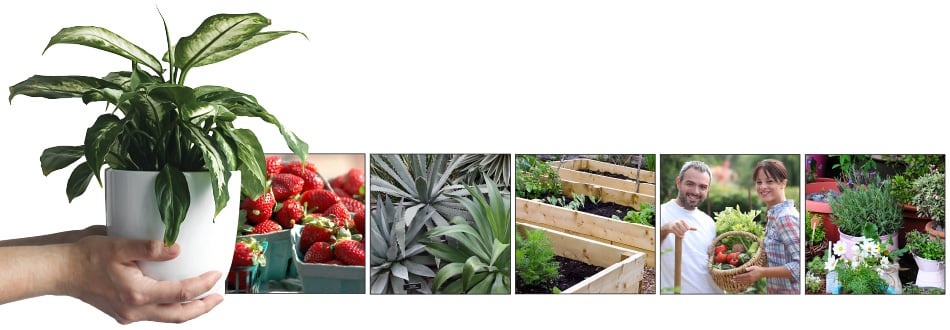
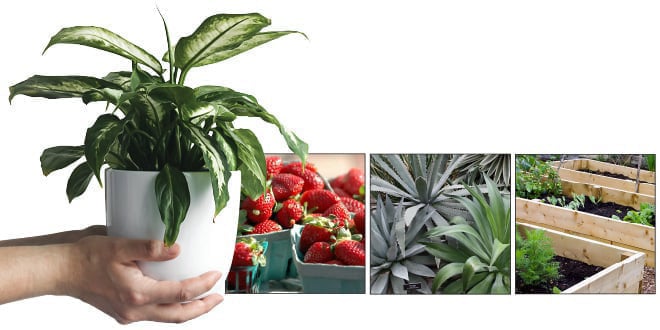
SoilRox™ functions in-soil on two levels: as a micro-sponge to capture and then slow-release moisture and nutrients in the root zone and as a physical conditioning amendment that improves the structure of poor native soils to improve vegetative vitality.
Blending Container Soils
It’s important to understand that native soils, no matter how serviceable in the garden plot—make poor potting (container) soils on their own. Successful container soils are highly specialized, engineered to meet the unique aeration and drainage demands of a closely confined growing space. A variety of pre-mixed-and-bagged potting soils are available to buy, often formulated for different plant types. Yet many prefer the control and cost savings of mixing their own, dialing in on the ideal mix design for the plant type and container size. Some container-soil designs even incorporate native garden soil, especially when facing the economics of filling large containers, numerous containers, or raised beds. SoilRox™ provides a high-performance option for any mix design.
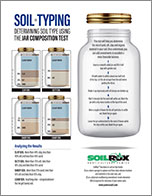 Determining Soil Type. If using some native soil for raised beds and other large-volume container applications, you might use the jar composition test (linked infographic) to determine what type of native soil you have.
Determining Soil Type. If using some native soil for raised beds and other large-volume container applications, you might use the jar composition test (linked infographic) to determine what type of native soil you have.
Mix Designs. The formulations below provide a general reference for incorporating typical native soils into containerized grow media. Tweaks will certainly need to be made. If the native soil is nutrient-and-microorganism poor, for example, a quality compost can be incorporated. What will be growing in the containerized soil matters too. Some plants demand more specialized soil designs, nutrition, and/or pH levels to thrive.
| DENSE/TIGHT: For native soils that tend to be dense with fine clay (or silt) particles, use (by measured volume) one part soil with three parts sphagnum peat (or comparable) and two parts SoilRox™—either Blender-SF or Enhancer-NF. |
| MIDDLING: If sourcing a medium-textured soil (silt loam or sandy clay loam), use two parts soil with three parts sphagnum peat (or comparable and two parts SoilRox™—either Blender-SF or Enhancer-NF. |
| LOAMY: To amend a well-structured native soil (loam) for container use, go one part native soil, one part sphagnum peat (or comparable) and one part SoilRox™—either Blender-SF or Enhancer-NF. |
Get it Right. Small-scale performance testing of any custom mix design is a good move—make sure it’s right before mixing and placing large quantities.
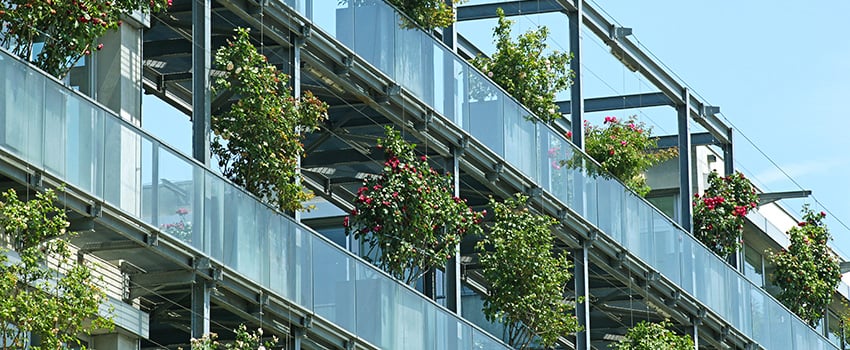
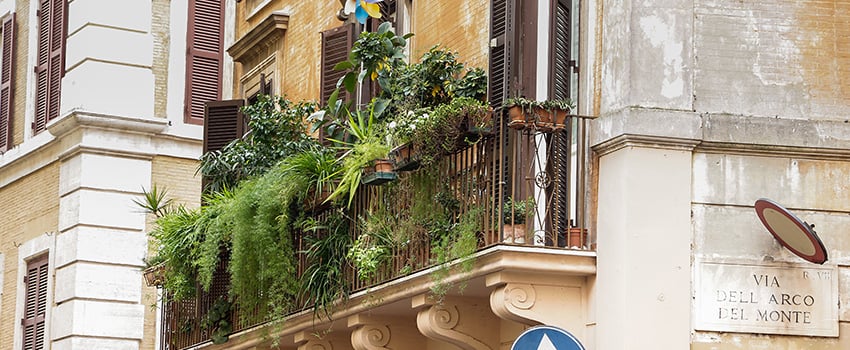
Urban dwellers—whether housed up in sleek modern or old-world quaint—rely on specialized soils in a resourceful variety of containers to bring growing things close to home.
Usage and Application Guidelines for Greenscapes
Low-maintenance, eye-pleasing, thriving landscapes—greenscapes—begin and end with well-structured soil. Sometimes the native soil is naturally right. Usually it’s not. SoilRox™ blend and amender grades are economical and highly effective conditioners for native soils that need structural and performance improvements. Combined with a quality compost to jumpstart the microbial health cycle, SoilRox makes poor soils highly functional.
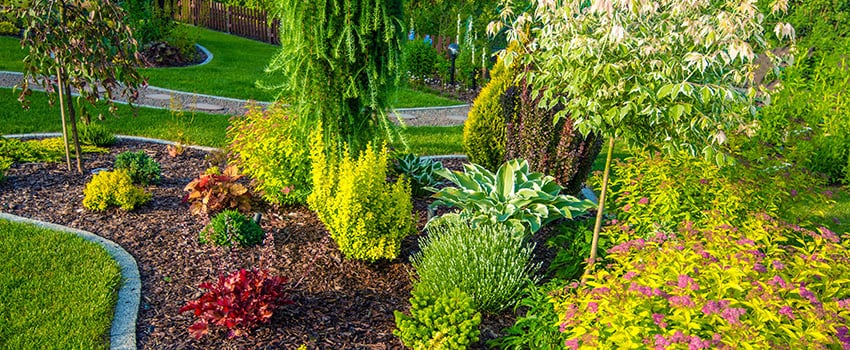
This newly-established greenscape incorporates a variety of plant shapes, textures and colors, a water-permeable walkway, and good mulch cover. The future health and beauty of this carefully designed landscape is fully dependant on the structural quality of the soil.
Turf Applications. SoilRox works great under turf fields and lawns. When blended 4 to 6 inches deep into the soil, it encourages deep root growth, drains quickly, holds moisture in the root zone and resists compaction from foot, mower and cart traffic.
Area Planting Applications. When using SoilRox to prepare soil for a non-turf landscaping project, apply to the entire area, not just in and around the planting holes of new shrubbery or ground cover plants.
Same goes for preparing planting beds for perennial flowers, herbs and crops like strawberries or raspberries. As your plantings mature and the growing root systems quest outward, they absolutely need to find the same amended-quality soil well beyond their original transplanting hole to encourage strong and well-dispersed roots.
The all-too-common tactic of digging a larger-than-the-root-ball-hole and then backfilling with a nutrient enhanced and structurally-amended soil—one that is significantly different from the surrounding native soil—is an ill-advised practice that master gardener Linda Chalker-Scott refers to as “enabling.” Enabling new plantings in this manner reduces growth rates and impairs plant health and even stability—especially problematic with trees. Why? Because when you improve only the structure and nutrition level of the soil used immediately under and around the new transplant, the new roots, instead of questing out into the native soil to establish a sustainable, vibrant root base, tend to curl back into the good stuff, unwilling to cross the interface between amended backfill soil and the denser, less nutrient-rich native soil.
If landscaping with deeper-rooting plants, blend the SoilRox deeper, guided by the projected reach of the root system(s) you’re introducing to the landscape.
Ideal Soil Structure. In general terms, the ideal structural makeup of soil is 25% air, 25% water, 45% mineral particulates and 5% organic matter. This balance is key to how well a soil supports vegetative cover. If the soil tends to compact, either as the result of surface traffic and/or because the soil particles are mostly of the fine clay or silt variety, a blend of frothy SoilRox™ will provide compaction resistance and hold the soil pore spaces open for proper air exchange, drainage, and moisture retention.
SoilRox™ (or a kiln-expanded shale product with a similar foamed structure) is the go-to solution for the engineered, compaction-resistant soils placed under hard-used turf fields or parks and beneath walkways, driveways and other paver-surfaced areas set amid a greenscape.
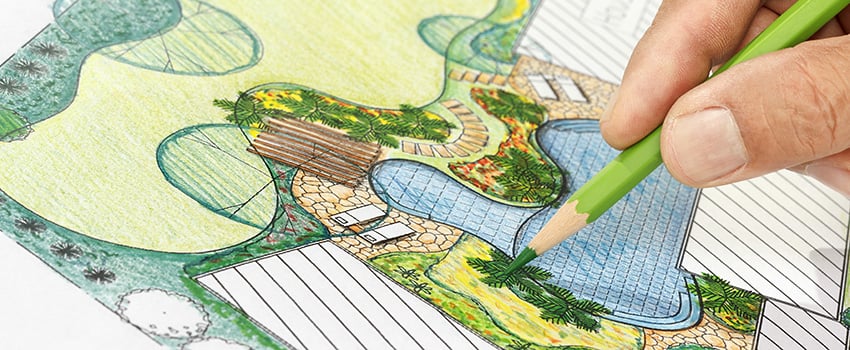
The careful planning of a successful greenscape not only considers the finished appearance, but also incorporates low-maintance elements and specifies a properly amended soil structure.
Application Rates. The following application rates are typical, and should be adjusted depending on soil type and performance demands.
| FINISHED AMENDED SOIL DEPTH | DEPTH OF SOILROX (BEFORE BLENDING) |
| 6 to 8 inches | 2 to 3 inches of SoilRox |
| 8 to 12 inches | 3 to 4 inches of SoilRox |
 Determining Soil Type. To get a good idea of the make-up of your native soil, you might use the jar composition test (linked infographic).
Determining Soil Type. To get a good idea of the make-up of your native soil, you might use the jar composition test (linked infographic).
The Case for Fines in Greenscapes. The signature foamed-stone character of SoilRox™ is present even in the small fines. These rough-surfaced, hole-pocked fines provide a more thorough dispersement within the soil, greatly expanding the surface area profile for moisture (and nutrient) retention on a micro level. Watering demands go down as wet bulk density soil capacity goes up. The fines work in conjunction with the larger pumice stones to diversify the pore space configuration, providing a more ideal balance between drainage and retention.
Organic Content. SoilRox™ adds no nutritional or microbial content to the soil. Soils low in organic content will need the addition of a quality compost as well. Composts also provide physical structure amendment, but the composted organic matter is soon broken down and consumed. Without an inorganic amendment like SoilRox in place, the soil will collapse to its poorly structured, poorly performing natural state. For greenscapes—which are not tilled and replanted annually like a garden plot—that’s unacceptable.
Mulches in Greenscapes. Surface mulches can contribute greatly to establishing a self-perpetuating nutritional cycle in the soil of a new greenscape, ensuring the effort put into improving the soil base will bear dividends for years to come. The soil beneath a properly maintained mulch cover remains rich, healthy and self-sustaining. Not to mention the advantages of moisture retention, soil temperature modulation, and weed suppression. Aged wood chips or shredded bark work wonderfully and are easy to source and replace as needed.
SoilRox™ Moisture Content. If the SoilRox blend or amender grades (those containing fines) have dried out, moistening slightly will help control the dust without affecting the blendability.
The EPA’s Greenscapes Initiative. A few years back, the U.S. Environmental Protection Agency published an extensive suite of how-to information to encourage home and business owners, landscape architects and others to use conservation-centric greenscape practices. The program centers on five steps—the first: “Build and Maintain a Healthy Soil.” Download a PDF file of the EPA’s “GreenScaping: The Easy Way to a Greener, Healthier Yard” brochure. Additional resources are archived on the EPA.gov website.